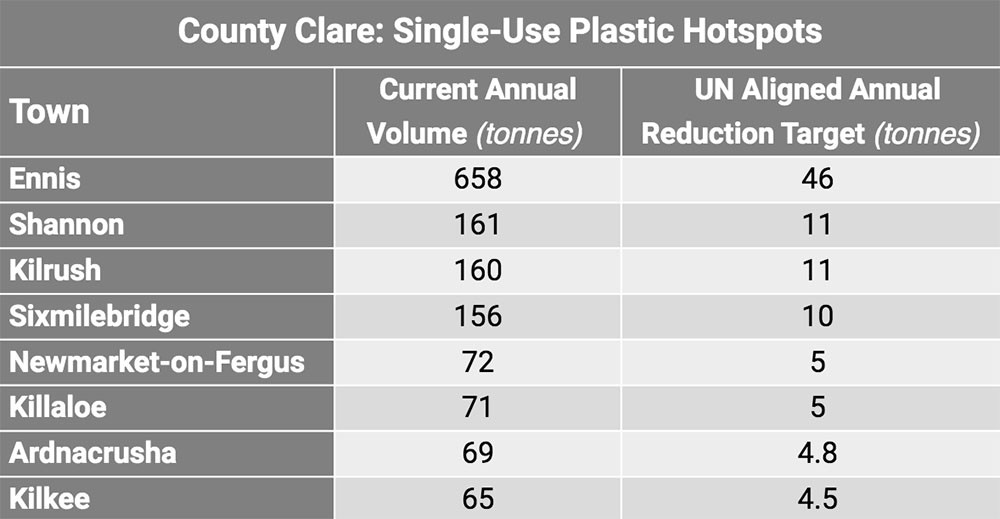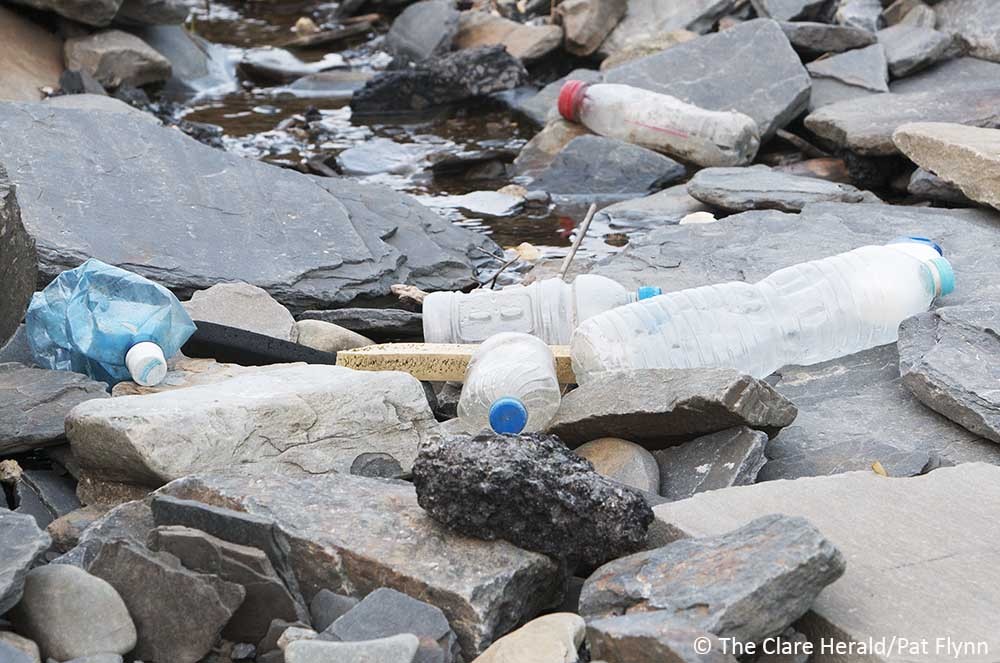
A study by Midlands based CUSP into the volumes of single-use plastic packaging waste generated across County Clare has identified hotspots in terms of volumes, which if given priority would see significant reductions in the amounts generated in the county each year.
Households in County Clare generate a combined 7,200 tonnes of single-use plastic packaging waste annually. That’s enough single-use plastic waste to fill 160 Olympic size swimming pools.
CUSP (Cease Using Single-Use Plastic) was established in 2018 to develop solutions to this burgeoning crises. ‘Our research found consumers are put-off trying to reduce single-use plastic waste by the continuous reporting of the crises in the ‘millions of tonnes’, according to CUSP founder Simon Ruddy. ‘This leaves people wondering ‘what’s the point trying to reduce… my small contribution is hardly going to make any difference’.
CUSP takes the big global numbers on single-use plastic waste, the ‘millions of tonnes’ we read about frequently and distils these numbers down into smaller bite-sized reduction targets community groups and households can more easily relate to; all delivered via CUSP’s user-friendly, free mobile app.

Ennis Town not surprisingly generates the highest volume at 1,300 tonnes annually, with Shannon generating less than half that at 550 tonnes. Kilrush and Sixmilebridge follow next with 175 and 162 tonnes respectively.
The table provided lists volumes for eight Clare towns, which cumulatively accounts for 36% of the counties annual single-use plastic waste pile. Also listed are reduction targets aligned to the key UN sustainability goal for the elimination of all non-essential single-use plastic packaging by 2030, estimated at 70% of current global consumption.
To achieve 70% reductions by 2030 County Clare would need to reduce single-use plastic waste from its current 7,200 tonnes annually to 2,200 tonnes annually by 2030.
Irish households generate on average 171kgs of single-use plastic waste annually, which is the highest in the EU, compared to France at 153kgs and the sustainability conscious Swedish at 55kgs per household, for example.
In order to achieve the 70% reduction described above, each household in the county would need to reduce from its current average of 171kgs annually, to 51kgs annually by 2030. That’s a reduction of 120kgs per household over the next decade. To put this in perspective, 171kgs is equivalent in weight to 3,000 empty 2ltr single-use plastic drinks bottles for example. 51kgs is equivalent to 900.
CUSP is asking households in County Clare to reduce by 12kgs annually.
Why 12kgs?
Because 12kgs annually (just 1kg monthly) over 10 years gives you 120kgs! Using the free CUSP app participants simply Identify 1kg monthly reductions and repeat that 1kg reduction each month for 12 months (12kgs annually); then target a further 1kg monthly reduction for the next 12 months. Very soon, we will collectively knock Ireland off that embarrassing EU top-spot and dramatically enhance the many beautiful beaches, tourist trails and amenity areas across County Clare.
Weights are preloaded for 22 of the more common items of single-use plastic packaging found in Irish homes. Users simply tap-in their estimated number-of-units day 1, for each of the 22 items listed; then, after 30 days and following CUSP ‘hints and tips for reducing’, users tap-in their new reduced volumes to see their reductions. All calculations and conversions-to-kilograms happen automatically.
200 households in the Connaught region participated in our pilot launch during February and March 2020, achieving average monthly reductions of 2.5kgs. With reductions of just 1kg per month required to hit UN 2030 sustainability goals, hitting these targets should not be a problem.
Growing concerns about the impact of single-use plastic waste on our oceans, marine life, human health (due to micro plastics) and, the contribution of plastic packaging production to climate change, due to significant CO2 emissions from its petrochemical based manufacturing process means we can no longer wait for legislators to solve this problem. There are simply too many vested interests with deep pockets, from a cross-section of industries pushing-back against any radical measures that would reverse these trends.
We each need to take more immediate and direct action in our own homes in order to defeat this environmental scourge.
‘Ultimately’, Simon concluded; ‘It is only when we as consumers start leaving products behind us on supermarket shelves when not happy with the amount of plastic used to package those products will true change take effect. Nothing will drive big brand manufacturers to switch to more sustainable forms of packaging faster than falling market share.
The CUSP app is available to download free – search ‘CUSP: Single-Use Plastic Calc’ (iOS & android).
